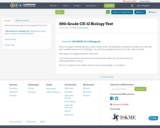
10th grade biology aligned to the standards that is free.
- Subject:
- Life Science
- Material Type:
- Full Course
- Author:
- John Kinney
- Date Added:
- 05/13/2015
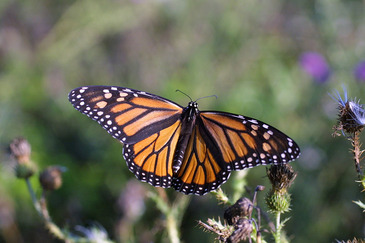

10th grade biology aligned to the standards that is free.
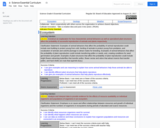
6th Grade Regular Science Scope & Sequence

In this course, you will learn the principles of genetics with application to the study of biological function at the level of molecules, cells, and multicellular organisms, including humans. We will cover structure and function of genes, chromosomes, and genomes; biological variation resulting from recombination, mutation, and selection; population genetics; and the use of genetic methods to modify genes and genomes and analyze protein function, gene regulation, and inherited disease.
This course, based on the MIT course 7.03 Genetics taken by enrolled MIT students, was organized as a three-part series on edX by MIT’s Department of Biology (Note: The third part of the course is not available yet). It is self-paced and free as long as you enroll in the Audit Track option, which you can select after creating a free account on edX.

In this course, you will engage in the biology of cells of higher organisms. You will study the structure, function, and biosynthesis of cellular membranes and organelles; cell growth and oncogenic transformation; transport, receptors, and cell signaling; the cytoskeleton, the extracellular matrix, and cell movements; cell division and cell cycle; functions of specialized cell types. This course emphasizes the current molecular knowledge of cell biological processes as well as the genetic, biochemical, and other experimental approaches that resulted in these discoveries.
This course, based on the MIT course 7.06 Cell Biology taken by enrolled MIT students, was organized as a three-part series on edX by MIT’s Department of Biology. It is self-paced and free as long as you enroll in the Audit Track option, which you can select after creating a free account on edX.

This course is an in-depth adventure through the molecular mechanisms that control the maintenance, expression, and evolution of prokaryotic and eukaryotic genomes. Through lectures and readings of relevant literature, students will explore gene regulation, DNA replication, genetic recombination, transcription, and mRNA translation. The quizzes are designed to build students' experimental design and data analysis skills.
This course, based on the MIT course 7.28/7.58 Molecular Biology taken by enrolled MIT students, was organized as a three-part series on edX by MIT’s Department of Biology. It is self-paced and free as long as you enroll in the Audit Track option, which you can select after creating a free account on edX.
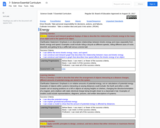
7th Grade Regular Science Scope & Sequence
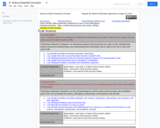
8th Grade Regular Science Scope & Sequence

This training course is an introduction to the use of the AFNI software suites for the analysis of functional MRI (fMRI) data. It is not intended as an introduction to how fMRI works but is aimed at people who are already doing fMRI data analysis, or those who will be in the near future.
AFNI (Analysis of Functional NeuroImages) is a leading software suite of C, Python, and R programs and shell scripts, primarily developed for the analysis and display of anatomical and fMRI data. It is freely available for research purposes.
This event was organized by the Center for Brains, Minds, and Machines (CBMM) Trainee Leadership Council.
CBMM is a multi-institutional NSF Science and Technology Center headquartered at MIT that is dedicated to developing a computationally based understanding of human intelligence and establishing an engineering practice based on that understanding. CBMM brings together computer scientists, cognitive scientists, and neuroscientists to create a new field—the science and engineering of intelligence.

Introduction to the linguistic study of language pathology, concentrating on experimental approaches and theoretical explanations. Discussion of Specific Language Impairment, autism, Down syndrome, Williams syndrome, normal aging, Parkinson's disease, Alzheimer's disease, hemispherectomy and aphasia. Focuses on the comparison of linguistic abilities among these syndromes, while drawing clear comparisons with first and second language acquisition. Topics include the lexicon, morphology, syntax, semantics and pragmatics. Relates the lost linguistic abilities in these syndromes to properties of the brain.

The Acoustics of Speech and Hearing is an H-Level graduate course that reviews the physical processes involved in the production, propagation and reception of human speech. Particular attention is paid to how the acoustics and mechanics of the speech and auditory system define what sounds we are capable of producing and what sounds we can sense. Areas of discussion include:
the acoustic cues used in determining the direction of a sound source,
the acoustic and mechanical mechanisms involved in speech production and
the acoustic and mechanical mechanism used to transduce and analyze sounds in the ear.
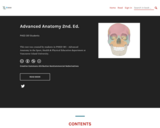
Short Description:
This text was created by students in PHED 301 - Advanced Anatomy in the Sport, Health & Physical Education department at Vancouver Island University.
Word Count: 115766
(Note: This resource's metadata has been created automatically by reformatting and/or combining the information that the author initially provided as part of a bulk import process.)

The course includes survey and special topics designed for graduate students in the brain and cognitive sciences. It emphasizes ethological studies of natural behavior patterns and their analysis in laboratory work, with contributions from field biology (mammology, primatology), sociobiology, and comparative psychology. It stresses mammalian behavior but also includes major contributions from studies of other vertebrates and of invertebrates. It covers some applications of animal-behavior knowledge to neuropsychology and behavioral pharmacology.

This course is a graduate introduction to natural language processing - the study of human language from a computational perspective. It covers syntactic, semantic and discourse processing models, emphasizing machine learning or corpus-based methods and algorithms. It also covers applications of these methods and models in syntactic parsing, information extraction, statistical machine translation, dialogue systems, and summarization. The subject qualifies as an Artificial Intelligence and Applications concentration subject.

12.491 is a seminar focusing on problems of current interest in geology and geochemistry. For Fall 2005, the topic is organic geochemistry. Lectures and readings cover recent research in the development and properties of organic matter.

This course introduces students to a quantitative approach to studying the problems of physiological adaptation in altered environments, especially microgravity and partial gravity environments. The course curriculum starts with an Introduction and Selected Topics, which provides background information on the physiological problems associated with human space flight, as well as reviewing terminology and key engineering concepts. Then curriculum modules on Bone Mechanics, Muscle Mechanics, Musculoskeletal Dynamics and Control, and the Cardiovascular System are presented. These modules start out with qualitative and biological information regarding the system and its adaptation, and progresses to a quantitative endpoint in which engineering methods are used to analyze specific problems and countermeasures. Additional course curriculum focuses on interdisciplinary topics, suggestions include extravehicular activity and life support. The final module consists of student term project work.

This course studies the relations of affect to cognition and behavior, feeling to thinking and acting, and values to beliefs and practices. These connections will be considered at the psychological level of organization and in terms of their neurobiological and sociocultural counterparts.

This course instructs students on how to develop technologies that help people measure and communicate emotion, that respectfully read and that intelligently respond to emotion, and have internal mechanisms inspired by the useful roles emotions play.

This course is an investigation of affective priming and creation of rigorously counterbalanced, fully computerized testing paradigm. Includes background readings, study design, counterbalancing, study execution, data analysis, presentation of poster, and final paper.

This course is offered to undergraduates and addresses several algorithmic challenges in computational biology. The principles of algorithmic design for biological datasets are studied and existing algorithms analyzed for application to real datasets. Topics covered include: biological sequence analysis, gene identification, regulatory motif discovery, genome assembly, genome duplication and rearrangements, evolutionary theory, clustering algorithms, and scale-free networks.
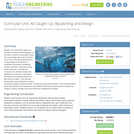
Bycatch, the unintended capture of animals in commercial fishing gear, is a hot topic in marine conservation today. The surprisingly high level of bycatch about 25% of the entire global catch is responsible for the decline of hundreds of thousands of dolphins, whales, porpoises, seabirds and sea turtles each year. Through this curricular unit, students analyze the significance of bycatch in the global ecosystem and propose solutions to help reduce bycatch. They become familiar with current attempts to reduce the fishing mortality of these animals. Through the associated activities, the challenges faced today are reinforced and students are stimulated to brainstorm about possible engineering designs or policy changes that could reduce the magnitude of bycatch.

This class analyzes complex biological processes from the molecular, cellular, extracellular, and organ levels of hierarchy. Emphasis is placed on the basic biochemical and biophysical principles that govern these processes. Examples of processes to be studied include chemotaxis, the fixation of nitrogen into organic biological molecules, growth factor and hormone mediated signaling cascades, and signaling cascades leading to cell death in response to DNA damage. In each case, the availability of a resource, or the presence of a stimulus, results in some biochemical pathways being turned on while others are turned off. The course examines the dynamic aspects of these processes and details how biochemical mechanistic themes impinge on molecular/cellular/tissue/organ-level functions. Chemical and quantitative views of the interplay of multiple pathways as biological networks are emphasized. Student work culminates in the preparation of a unique grant application in an area of biological networks.

This course focuses on computational and experimental analysis of biological systems across a hierarchy of scales, including genetic, molecular, cellular, and cell population levels. The two central themes of the course are modeling of complex dynamic systems and protein design and engineering. Topics include gene sequence analysis, molecular modeling, metabolic and gene regulation networks, signal transduction pathways and cell populations in tissues. Emphasis is placed on experimental methods, quantitative analysis, and computational modeling.

Short Description:
This book is adapted from Anatomy and Physiology by Openstax. The text is designed to supplement an Anatomical Basis of Injury in Athletic Training course while providing review of basic Anatomy and Physiology.
Word Count: 124069
(Note: This resource's metadata has been created automatically by reformatting and/or combining the information that the author initially provided as part of a bulk import process.)

Short Description:
This textbook is designed to actively engage your exploration and critical analysis of human anatomical variation in an Australian and New Zealand context. Understanding anatomical variation is essential for all health professionals to avoid patient misdiagnosis such as confusing a natural variant with a pathology, minimise surgical or procedural errors that may occur if variations are unexpected, and ultimately improve patient outcomes by applying culturally safe practices. Research in anatomical variation has demonstrated significant differences in phenotypic expression of variants between and within geographic, ancestral and socioeconomic populations, as well as displaying significant variance between males and females. It is therefore critical as a health professional to understand anatomical variation in the context of the population you intend to practice in. This textbook compiles this critical information into an easy to read summary of the range and frequency of anatomical phenotypes in Australian and New Zealand patients by drawing from contemporary anatomical science research. Anatomical variation of Aboriginal, Torres Strait Islander and Māori peoples has also been highlighted where research is available.
Long Description:
The anatomy of our outwardly facing physical appearance exhibits great diversity between individuals, from different eye, skin and hair colour to the size of our feet and our height. However, it is less known whether our anatomy differs beneath the surface… is the anatomy of the internal organs the same between individuals? Most textbooks would like you to think so with simplified standard descriptions of human anatomy such as the lung lobes and fissures, aortic arch branches and bone numbers. But this eBook is different. Here we build your understanding of the scope and clinical importance of human anatomical variation to improve your clinical skills as a health professional or biomedical scientist.
Anatomical variation is described as the differences in macroscopic morphology (shape and size), topography (location), developmental timing or frequency (number) of an anatomical structure between individuals. It presents during embryological or subadult development and results in no substantive observable interruption to physiological function. Every organ displays an array of anatomical phenotypes, and for these reasons the anatomy of each person is considered a variant. Understanding anatomical variation is essential for all health professionals to avoid patient misdiagnosis such as confusing a natural variant with a pathology, minimise surgical or procedural errors that may occur if variations are unexpected, and ultimately improve patient outcomes by applying culturally safe practices.
This textbook is designed to actively engage your exploration and critical analysis of human anatomical variation in an Australian and New Zealand context. Research in anatomical variation has demonstrated significant differences in phenotypic expression of variants between and within geographic, ancestral and socioeconomic populations, as well as displaying significant variance between males and females. It is therefore critical as a health professional to understand anatomical variation in the context of the population you intend to practice in. This textbook compiles this critical information into an easy to read summary of the range and frequency of anatomical phenotypes in Australian and New Zealand patients by drawing from contemporary anatomical science research. Anatomical variation of Aboriginal, Torres Strait Islander and Māori peoples has also been highlighted where research is available.
The textbook is organised to complement your health science studies by developing your depth of understanding to address three critical themes in anatomical variation: Theme 1: Categorise and describe a range of anatomical variation within the human body. Theme 2: Theorise the implications of anatomical variation on patient outcomes and in professional contexts. Theme 3: Investigate the process of anatomical variation formation and its potential causes.
Each chapter employs a multimodal and active learning approach using text and video summaries of key information, checkpoint quizzes, interactive images, clinical and professional discussion activities, and recommended readings. In this way, the activities in this textbook can be easily embedded into existing health science curricula to strengthen anatomical variation understanding in all health professional courses.
Word Count: 31978
ISBN: 978-1-925553-51-2
(Note: This resource's metadata has been created automatically by reformatting and/or combining the information that the author initially provided as part of a bulk import process.)

Short Description:
This textbook is designed to actively engage your exploration and critical analysis of human anatomical variation in an Australian and New Zealand context. Understanding anatomical variation is essential for all health professionals to avoid patient misdiagnosis such as confusing a natural variant with a pathology, minimise surgical or procedural errors that may occur if variations are unexpected, and ultimately improve patient outcomes by applying culturally safe practices. Research in anatomical variation has demonstrated significant differences in phenotypic expression of variants between and within geographic, ancestral and socioeconomic populations, as well as displaying significant variance between males and females. It is therefore critical as a health professional to understand anatomical variation in the context of the population you intend to practice in. This textbook compiles this critical information into an easy to read summary of the range and frequency of anatomical phenotypes in Australian and New Zealand patients by drawing from contemporary anatomical science research. Anatomical variation of Aboriginal, Torres Strait Islander and Māori peoples has also been highlighted where research is available.
Long Description:
The anatomy of our outwardly facing physical appearance exhibits great diversity between individuals, from different eye, skin and hair colour to the size of our feet and our height. However, it is less known whether our anatomy differs beneath the surface… is the anatomy of the internal organs the same between individuals? Most textbooks would like you to think so with simplified standard descriptions of human anatomy such as the lung lobes and fissures, aortic arch branches and bone numbers. But this eBook is different. Here we build your understanding of the scope and clinical importance of human anatomical variation to improve your clinical skills as a health professional or biomedical scientist.
Anatomical variation is described as the differences in macroscopic morphology (shape and size), topography (location), developmental timing or frequency (number) of an anatomical structure between individuals. It presents during embryological or subadult development and results in no substantive observable interruption to physiological function. Every organ displays an array of anatomical phenotypes, and for these reasons the anatomy of each person is considered a variant. Understanding anatomical variation is essential for all health professionals to avoid patient misdiagnosis such as confusing a natural variant with a pathology, minimise surgical or procedural errors that may occur if variations are unexpected, and ultimately improve patient outcomes by applying culturally safe practices.
This textbook is designed to actively engage your exploration and critical analysis of human anatomical variation in an Australian and New Zealand context. Research in anatomical variation has demonstrated significant differences in phenotypic expression of variants between and within geographic, ancestral and socioeconomic populations, as well as displaying significant variance between males and females. It is therefore critical as a health professional to understand anatomical variation in the context of the population you intend to practice in. This textbook compiles this critical information into an easy to read summary of the range and frequency of anatomical phenotypes in Australian and New Zealand patients by drawing from contemporary anatomical science research. Anatomical variation of Aboriginal, Torres Strait Islander and Māori peoples has also been highlighted where research is available.
The textbook is organised to complement your health science studies by developing your depth of understanding to address three critical themes in anatomical variation: Theme 1: Categorise and describe a range of anatomical variation within the human body. Theme 2: Theorise the implications of anatomical variation on patient outcomes and in professional contexts. Theme 3: Investigate the process of anatomical variation formation and its potential causes.
Each chapter employs a multimodal and active learning approach using text and video summaries of key information, checkpoint quizzes, interactive images, clinical and professional discussion activities, and recommended readings. In this way, the activities in this textbook can be easily embedded into existing health science curricula to strengthen anatomical variation understanding in all health professional courses.
Word Count: 31376
(Note: This resource's metadata has been created automatically by reformatting and/or combining the information that the author initially provided as part of a bulk import process.)
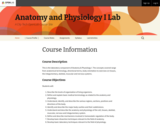
This is the laboratory component of Anatomy & Physiology I. The concepts covered range from anatomical terminology, directional terms, body orientation to exercises on tissues, the integumentary, skeletal, muscular and nervous systems.

The Anatomy Quizbook is an interactive learning book that will help students and tutors – indeed anyone interested in anatomy – learn, test and improve their knowledge of the human body.
Readers are presented with carefully selected questions and diagrams addressing core learning in clinically-relevant anatomy. This selective rather than exhaustive approach will especially suit time-poor scholars. Regular self-testing will also ensure a robust and strategic understanding of the subject matter.
In this first Volume, you can develop your knowledge of fundamental anatomy, including clinically-relevant terminology and the significant parts and operation of the:
- Thorax, focusing on the heart, lungs, and associated bones, muscles, nerves, blood and lymphatic vessels.
- Abdomen, exploring the stomach, intestines, pancreas, liver, gallbladder, kidneys, spleen and their supporting structures (muscles, nerves, blood and lymphatic vessels).
- Pelvis, examining the bones, ligaments, vessels and nerves of the pelvic region, the features of male and female pelves, and the major digestive and excretory organs (colon, rectum, bladder and urethra).
Whilst developed primarily for students who are studying, or intend to study, medicine, the Anatomy Quizbook will reward all readers who seek to explore and learn about the workings of the human body.
Regular users will find much to learn and build on, hopefully leading to further enthusiasm for a valuable subject that underpins much of medicine.

OpenStax
Short Description:
An adapted and revised edition of the OpenStax Anatomy & Physiology (https://openstax.org/details/books/anatomy-and-physiology) with revised content and artwork, Open Oregon State, Oregon State University. Data Dashboard
Long Description:
An adapted and revised edition of the OpenStax Anatomy & Physiology (https://openstax.org/details/books/anatomy-and-physiology) with revised content and artwork, Open Oregon State, Oregon State University.
Word Count: 551108
(Note: This resource's metadata has been created automatically by reformatting and/or combining the information that the author initially provided as part of a bulk import process.)

This is the open educational resource for BIO2311: Anatomy & Physiology I. This site provides all you will need for the course including a syllabus, link to the textbook, lecture notes, assignments, and all other related resources.
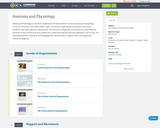
Anatomy and Physiology is a dynamic textbook for the two-semester human anatomy and physiology course for life science and allied health majors. The book is organized by body system and covers standard scope and sequence requirements. Its lucid text, strategically constructed art, career features, and links to external learning tools address the critical teaching and learning challenges in the course. The web-based version of Anatomy and Physiology also features links to surgical videos, histology, and interactive diagrams.

Anatomy and Physiology is a dynamic textbook for the two-semester human anatomy and physiology course for life science and allied health majors. The book is organized by body system and covers standard scope and sequence requirements. Its lucid text, strategically constructed art, career features, and links to external learning tools address the critical teaching and learning challenges in the course. The web-based version of Anatomy and Physiology also features links to surgical videos, histology, and interactive diagrams.
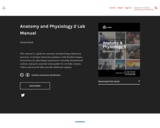
Short Description:
This manual is a guide for anatomy and physiology laboratory exercises. It includes dissection guidance with detailed images; instructions for physiology experiments including foundational content; and gross anatomy study guides for six body systems. Videos and tutorial links provide additional support.
Word Count: 12116
ISBN: 978-1-948027-09-0
(Note: This resource's metadata has been created automatically by reformatting and/or combining the information that the author initially provided as part of a bulk import process.)
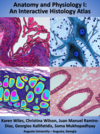
This Anatomy and Physiology I Histology Atlas helps students better understand the complex discipline of tissue histology with the use of interactive H5P activities. Students can reveal or hide illustration overlays drawn to help students visualize cell- and tissue-level structures.
This open access histology atlas was made possible through generous grant funding by The University System of Georgia through the Affordable Learning Georgia initiative: https://www.affordablelearninggeorgia.org/.
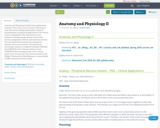
Anatomy and Physiology II syllabi and supplemental materials. This course covers a survey of the human body that stresses biological principles, chemical interpretations, and physical applications at the various levels of organization. The class lectures cover embryonic and physiologic theories of muscular, nervous, integument, skeletal, and endocrine systems. The class laboratories examine the integument, skeletal, and nervous systems. The department encourages students to complete Principles of Biology II/Lab (BIO102) and/or Chemical Science I/Lab (CHM110) before enrolling in this course. Course meets: 3 hrs. lecture; 3 hrs. lab. Course materials by Dr. Phillip T. Wong and Dr. Mark Beaumont, content added to OER Commons by Victoria Vidal.
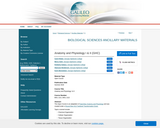
This Open Course is an adaptation of OpenStax Anatomy and Physiology and was created under a Round Nine ALG Textbook Transformation Grant.
Topics covered include:
Chemical Organization
Cellular Organization
Tissue Organization
Integumentary System
Skeletal System
Muscular System
Nervous System
Endocrine System
Cardiovascular System
Lymphatic System
Respiratory System
Digestive System
Reproductive System
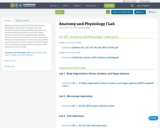
Syllabi and Lab Exercises for SCI 201: Anatomy and Physiology I. This course is designed to provide students with a basic understanding of the structure, function and disorders of the human body. Topics include an overview of the integumentary, skeletal, muscular, and nervous systems, as well as a discussion of tissues and special senses. A three-hour lab session is required each week. Course materials written by Maria Carles and Georgia Thoidis, content uploaded to OER Commons by Victoria Vidal.
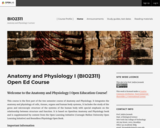
This course is the first part of the two semester course of Anatomy and Physiology. It integrates the anatomy and physiology of cells, tissues, organs and human body systems, It includes the study of the gross and microscopic structure of the systems of the human body with special emphasis on the relationship between structure and function. It is based on OpenStax Anatomy and Physiology book and is supplemented by content from the Open Learning Initiative (Carnegie Mellon University Open Learning Initative) and Boundless Physiology Open Book.
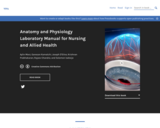
Word Count: 741633
(Note: This resource's metadata has been created automatically by reformatting and/or combining the information that the author initially provided as part of a bulk import process.)

These are PDFs of each chapter of the OpenStax Anatomy and Physiology textbook. They can be posted to D2L for easy access for students.
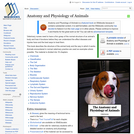
Veterinary nurses need to have a firm grasp of the normal structure of an animal’s body and how it functions before they can understand the effect diseases and injuries have and the best ways to treat them. This book describes the structure of the animal body and the way in which it works. Animals encountered in normal veterinary practice are used as examples where possible.

Introduction to Biotechnology II (BIOL1415), provides learners with a practical exploration of a regulated biotechnology workplace. This course is a continuation of Introduction to Biotechnology I (BIOL 1414), and the cornerstone for the Biotechnology Level-One Certificate, as it provides students ample opportunity to master entry-level laboratory workforce skills. This course builds on knowledge in biotechnology, chemistry, & biology, and provides workforce training in areas of regulatory documentation, equipment validation, and teamwork. The goals of this course are to develop core laboratory skills needed in a bioscience lab job; critical thinking and multitasking, teamwork and accountability, accuracy in calculations and experimental analysis, and demonstrate skills associated with working in a regulated laboratory workplace.

The introductory topics will cover various approaches to the study of animals and their behavior. Key concepts in studies of animal behavior, emphasizing ethology, are covered in class and in the assigned readings from Scott (2005), supplemented by selections from other books, especially from classics in the field as well as selected videos. Next, key concepts in sociobiology are covered using readings from Alcock (2001), supplemented by selections from additional books and some video presentations.

Animal welfare has been described as a complex, multi-faceted public policy issue which includes important scientific, ethical, and other dimensions. Improving our understanding of animal welfare, involves the fascinating study of animal behavior as well as the challenge of accessing the emotions of animals.
This is the On-Demand version of this course, which means you can start the course at any time and work through the course materials at your own pace. The materials and quizzes will always be available to you.
You can come and talk about the course on Twitter using the hashtag #EdAniWelf

Hello Readers, My name is Eddie Joo and I am the co-author as well as the person behind the cover art for this OER. The reason I chose the specific elements on the cover are relatively simple. I dislike the textbooks that just slap random images or things related to the subject and make the cover look really busy. I don't know about you, but any poster or ad that has something to do with Alaska usually includes mountains so I chose the ocean/water instead. Same reason with the animals as the Bear, Wolf, etc. are the go to animals when portraying Alaska so a Dall Sheep, Orca, and an Owl grace the cover. Last but most important to me is the sunrise/sunset gradient. I love seeing both in the winter and is special to me so I added it in as a little Easter egg for me. I hope you enjoy this book! Regards, Eddie
Long Description:
This book is the first edition (Fall 2022) to the exploration of two main core concepts in physiology; Systems Integration, and Homeostasis, in animals at the tissue and organ system level. The flow of this book focuses on how organ systems work together. Foundational homeostatic principles are introduced within the first chapter and threaded throughout the chapters within this text. This text was created by Eddie Joo to supplement students learning within the University of Alaska Anchorage’s Animal Physiology course. The content in this open textbook was adapted from other open textbooks (CC-BY-4.0) resources or created/written by Rachael Hannah and Eddie Joo. This work was funded by an Institutional Development Award (IDeA) from the National Institutes of Health as a Curriculum grant from ALASKA INBRE.
Word Count: 53586
(Note: This resource's metadata has been created automatically by reformatting and/or combining the information that the author initially provided as part of a bulk import process.)

This course applies the tools of anthropology to examine biology in the age of genomics, biotechnological enterprise, biodiversity conservation, pharmaceutical bioprospecting, and synthetic biology. It examines such social concerns such as bioterrorism, genetic modification, and cloning. It offers an anthropological inquiry into how the substances and explanations of biology—ecological, organismic, cellular, molecular, genetic, informatic—are changing. It examines such artifacts as cell lines, biodiversity databases, and artificial life models, and using primary sources in biology, social studies of the life sciences, and literary and cinematic materials, and asks how we might answer Erwin Schrodinger’s 1944 question, “What Is Life?” today.

The lethal poison Ricin (best known as a weapon of bioterrorism), Diphtheria toxin (the causative agent of a highly contagious bacterial disease), and the widely used antibiotic tetracycline have one thing in common: They specifically target the cell's translational apparatus and disrupt protein synthesis.
In this course, we will explore the mechanisms of action of toxins and antibiotics, their roles in everyday medicine, and the emergence and spread of drug resistance. We will also discuss the identification of new drug targets and how we can manipulate the protein synthesis machinery to provide powerful tools for protein engineering and potential new treatments for patients with devastating diseases, such as cystic fibrosis and muscular dystrophy.
This course is one of many Advanced Undergraduate Seminars offered by the Biology Department at MIT. These seminars are tailored for students with an interest in using primary research literature to discuss and learn about current biological research in a highly interactive setting. Many instructors of the Advanced Undergraduate Seminars are postdoctoral scientists with a strong interest in teaching.

El presente manuscrito es resultado de investigaciones multidisciplinarias bajo diferentes perspectivas científicas-académicas, mediante la confrontación de criterios de diferentes autores bajo un enfoque descriptivo que señala la importancia de ética en varios escenarios actuales como son en la discriminación de la mujer en ambiente laboral, el manejo de los individuos dentro de las organizaciones, dentro de la agricultura al momento de producir y cultivar, como la ética afecta al clima organizacional y lagestión docente dentro del caso de estudio de una universidad, la ética y la responsabilidad social empresarial como reto de las empresas, la discriminación laboral como comportamiento poco ético en el área de recursos humanos, y por ultimo una contrastación de la ética en la publicidad de las empresas. Estos estudios se realizan desde una mirada científica y se la acerca a la realidad ecuatoriana.
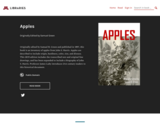
Short Description:
Originally edited by Samuel B. Green and published in 1897, this book is an inventory of apples from John S. Harris. Apples are described to include origin, hardiness, color, size, and disease. This 2019 edition includes the transcribed text and original line drawings, and has been expanded to include a biography of John S. Harris. Professor James Luby introduces 21st century readers to this historical document.
Word Count: 20069
ISBN: 978-1-946135-56-8
(Note: This resource's metadata has been created automatically by reformatting and/or combining the information that the author initially provided as part of a bulk import process.)

The eBook “Applications of Plant Pathology in Genebank Collections” was developed in part by USDA-ARS and by grant 2020-70003-30930 from the USDA-NIFA-Higher Education Challenge Grant Program. Additional chapters will be added to this eBook when they are available. This eBook contains chapters that can be accessed in any order. Click on “Contents” in the upper left corner and then expand “Main Body” to access chapter titles; scrolling may be necessary to view all chapter titles. Chapters can also be navigated by using arrows at the bottom of each page. Each chapter has text, video and/or interactive content on a single page.
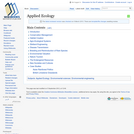
Applied ecology is a framework for the application of knowledge about ecosystems so that actions can be taken to create a better balance and harmony between people and nature in order to reduce human impact on other beings and their habitats.
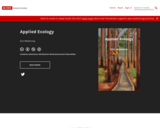
About this book
Origin story
I (Erin) began this book project after participating in the Open Pedagogy Incubator hosted by the NC State University Libraries in 2020, with the goal of making my course materials – and information about Applied Ecology – more broadly accessible to students, educators, and the general public. Rather than impose my sole voice, perspective, and biases, I restructured my course assignments to enable student creation of the content you will encounter in this book. The assignments are open-ended and open-world, motivating students to collaborate with each other and to seek knowledge beyond the classroom, and thus embody core characteristics of the discipline of Applied Ecology as well as Open Education and Universal Design for Learning. I hope that by centering student voices and by highlighting diverse scientists, research systems and ecosystems, this work empowers the reader and highlights the relevance of Applied Ecology in our everyday lives.
Intended use
This book is formatted to provide information about key ecological principles, concepts, and processes, explored and applied across various contexts. The text can be used as a foundational or supplementary text for ecology courses, or as a standalone reference for students in formal academic settings or beyond.
The Vocabulary terms at the beginning of each chapter are listed in the order that students will encounter them while reading the blog-style summary for that chapter. The Glossary lists all terms in the entire book in alphabetical order, for quick reference as needed.
We have provided an appendix with skeletal outlines that students can use to guide their notetaking. I also intend to compile a companion volume for educators, containing templates for each assignment used to guide the student works presented here.
Accessibility
We use sans-serif fonts to facilitate readability in digital format and by readers who are neurodivergent. We also support screen readership through alt-text images.
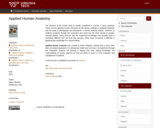
The structure of the human body is usually considered in courses in gross anatomy. These courses typically consist of lectures by the faculty, readings in assigned textbooks and the study of photographs and illustrations in human anatomy atlases. However, as student’s progress through the curriculum and move into the more clinical or practice oriented phases, many discover that the anatomical knowledge they actually need is somewhat different from the kind they possess. What many encounter is difficulty in applying their knowledge to a clinical setting.
Applied Human Anatomy was created to better integrate material that is more often than not treated separately in contemporary health care curricula. It is hoped that through this integration students will develop a deeper and more lasting knowledge and understanding of human anatomy as they are likely to need it in the evaluation and management of patients.
A print version is available for purchase on Amazon.
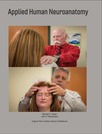
This 155-page manual is comprised of two types of learning activities: 1) free response fill-in-the blank questions focused of the facts and principles of neuroanatomy and neurophysiology that underpin the neurologic examination and specifically developed exercises that demonstrate how the facts and principles are related to the particular tests and procedures that comprise the neurologic examination. Free response questions form the bulk of the Neuroscience Review section of each chapter and are intended as a review of information previously or concurrently being learned regarding the structure, function and organization of the nervous system. Some questions focus on anatomical or physiological facts and relationships that help explain why certain techniques are performed as they are, such as why non-nociceptive tactile stimuli are required in order to activate nerve impulse transmission in the lemniscal system. Other questions are intended to revisit facts and concepts that are needed to properly interpret the elicited findings. 2) The Application Exercises of each chapter are designed to demonstrate how neuroanatomical and neurophysiological information is used in the design of particular clinical tests of neurologic function. The application exercises are also intended to help users learn how to perform and become comfortable with the various clinical maneuvers and tests that comprise the routine neurologic examination. An important outcome of performing these exercises is that, as a member of a learning group, each individual has the opportunity to experience the neurologic examination from the point of view of the subject (patient)—an experience that arguably provides insight and understanding that can be gained in no other way.

Grade level: graduate students, advanced undergrads, persons with analyzed research results
Course length: 1 semester, 4-6 months
Objective: This course empowers scientists to engage with their own data, each other, and the public through art. Through collective brainstorming, prototyping, and feedback from professional artists, students will create a project that expresses their own research through any artistic medium of their choice. The course typically culminates in a public art exhibition where students interact with a general audience to discuss their research, art, and what it means to be a scientist.
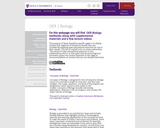
OER | Biology Overview:
On this webpage you will find OER Biology textbooks along with supplemental materials and a few lecture videos.
The purpose of these discipline-specific webpages is to display content that might be of interest to faculty who are considering adopting open educational resources for use in their classes. This list of content is by no means exhaustive. The nature of open educational resources is very collaborative and it is in that spirit that we encourage any comments about the content featured on this page or recommendations of content that are not already listed here.
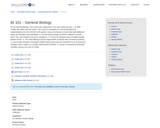
BI 101 is an introductory lab science course intended for majors in disciplines other than the biological sciences. This course is designed to help you discover the applications of science to your everyday life, as well as provide elements of critical thinking. This course has four Credit Units that emphasize a variety of topics including ecological principles, biodiversity, and impact of human activities on the environment.
Course Outcomes:
1. Discuss biological community interactions.
2. Explain how changes in human population and/or actions impact natural ecosystems.
3. Describe the movement of energy & nutrients through trophic levels.
4. Recognize the appropriate taxonomic level of an organism based on key characteristics or traits.
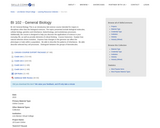
This is an introductory lab science course intended for majors in disciplines other than the biological sciences. The topics presented include biological molecules, cellular biology, genetics and inheritance, biotechnology, and evolutionary processes. Additionally, the course is designed to help you discover the applications of science in your everyday life, as well as provide elements of critical thinking.
Course Outcomes:
1. Explain how natural selection drives evolution.
2. Express how changes in the genome can affect the phenotype or traits within a population.
3. Be able to describe the patterns of inheritance.
4. Be able describe selected key cell processes.
5. Distinguish between the groups of biomolecules.

This course is designed to be taught using the textbook Cell Biology for Health Occupations, adapted from OpenStax.
(http://cnx.org/contents/Th3V8ojZ@3.1:zMTtFGyH@4/Introduction).

Word Count: 12858
(Note: This resource's metadata has been created automatically by reformatting and/or combining the information that the author initially provided as part of a bulk import process.)
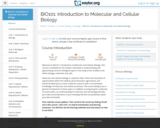
This course is designed for students who want to learn about and appreciate basic biological topics while studying the smallest units of biology: molecules and cells.